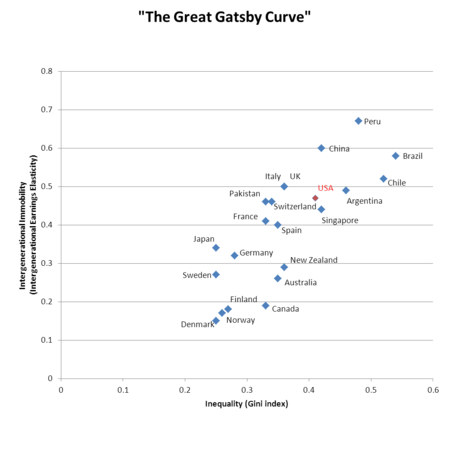Great Gatsby curve
The Great Gatsby curve is a chart plotting the relationship between inequality and intergenerational social immobility in several countries around the world.

Overview
The curve was introduced in a 2012 speech by chairman of the Council of Economic Advisers Alan Krueger,[1][2][3] and the President's Economic Report to Congress,[4] using data from labor economist Miles Corak. The name was coined by former Council of Economic Advisers (CEA) staff economist Judd Cramer,[5] for which he was given a bottle of wine as a reward.[6] The curve relates intergenerational income elasticity—a measure of the persistence of incomes between parents and their children—and inequality in the United States and twelve other developed countries,[7] though some versions of the curve include developing countries.[8] Countries with low levels of inequality such as Denmark, Norway, and Finland have some of the greatest mobility, while the two countries with the highest level of inequality—Chile and Brazil—have some of the lowest mobility.
The name of the curve refers to F. Scott Fitzgerald's novel The Great Gatsby. The eponymous character, Jay Gatsby embodies the (paradoxical) concept of mobility, rising from being a bootlegger to leading the Long Island north shore social set.[9]
Journalist Robert Lenzner and lawyer Nripendra Chakravarthy call it "a very frightening curve that requires policy attention."[9] Krueger predicted that "the persistence in the advantages and disadvantages of income passed from parents to the children" will "rise by about a quarter for the next generation as a result of the rise in inequality that the U.S. has seen in the last 25 years."[7]
Journalist Timothy Noah argued the effect results from growing inequality:
"you can't really experience ever-growing income inequality without experiencing a decline in Horatio Alger-style upward mobility because (to use a frequently-employed metaphor) it's harder to climb a ladder when the rungs are farther apart."[7]
Another journalist argued that a connection between income inequality and low mobility could be explained by the lack of access for un-affluent children to better (more expensive) schools and if this enabled access to high-paying jobs; or to differences in health care that may limit education and employment.[10]
However, some argue that the apparent connection may arise as an artifact of heterogeneous variance in ability across nations, questioning the need for intervention. It was shown that the manner in which the intergenerational income elasticity is defined, is by design associated with inequality.[11] Harvard economist Greg Mankiw noted that "this correlation is not particularly surprising", showing that comparisons of more diverse groups (like the US) with less diverse groups (like the population of Denmark) will automatically exhibit this phenomenon even when there are in fact no differences in the processes of mobility between these groups, i.e., the curve is an artifact of diversity.[12] His quote:
Germans are richer on average than Greeks, and that difference in income tends to persist from generation to generation. When people look at the Great Gatsby curve, they omit this fact, because the nation is the unit of analysis. But it is not obvious that the political divisions that divide people are the right ones for economic analysis. We combine the persistently rich Connecticut with the persistently poor Mississippi, so why not combine Germany with Greece?[12]
A blog[13] by M.S. at The Economist replied to Mankiw's counter-argument as follows:
The argument over the Great Gatsby curve is an argument about whether America's economy is fair. With his Germany/Greece and Mississippi/Connecticut analogy, Mr Mankiw has stumbled on a very convincing point: whether you are rich or poor in Europe or America depends to a great extent not on your own qualities or efforts, but on where you happen to be born. America is not a meritocracy, Mr Mankiw is saying; not only do those born rich tend to stay rich and vice versa, just being born in one state or another makes a huge difference to your lifelong earnings. Amazingly, he seems completely unaware that this is the case he's just made.
Economist Paul Krugman has also countered Mankiw's arguments in his column.[14]
Carter Price of the WCEG suggests "the line to serfdom" as an alternative name on the grounds that it may better convey the meaning of the correlation.[15]
See also
Notes
- Krueger, Alan (12 January 2012). "The Rise and Consequences of Inequality in the United States" (PDF).
- Krugman, Paul (15 January 2012). "The Great Gatsby Curve". New York Times.
- "The Great Gatsby Curve - Explained". Bloomberg Visual Data. 6 October 2013.
- "Economic report of the President" (PDF). United States Government Printing Office. February 2012.
- Nicorvo, Jay Baron (19 April 2015). "The 1 Percent Plays us for Suckers: There is no Meritocracy and They've Strangled the American Dream". Salon.
- Greeley, Brendan (12 December 2013). "The Gatsby Curve: How Inequality Became a Household Word". Bloomberg.
- Noah, Timothy (13 January 2012). "White House: Here's Why You Have To Care About Inequality".
- Corak graphs 25 countries, Krueger limits his to developed countries and lists 10
- Lenzner, Robert (26 March 2012). "Income Inequality From Generation To Generation". Forbes.
- DeParle, Jason (4 January 2012). "Harder for Americans to Rise From Lower Rungs".
- Berman, Yonatan (7 Sep 2017). "Understanding the Mechanical Relationship between Inequality and Intergenerational Mobility". SSRN 2796563. Cite journal requires
|journal=(help) - Mankiw, Greg (18 July 2013). "Observations on the Great Gatsby Curve".
- S., M. (22 July 2013). "The Great Gatsby curve - Don't worry, old sport". The Economist.
- Krugman, Paul (22 June 2013). "Greg Mankiw and the Gatsby Curve".
- Price, Carter (11 March 2014). "A response to another attack on the Great Gatsby curve—and can we call it the "line to serfdom" instead?". Washington Center for Equitable Growth.
Further reading
- Stewart, Matthew (June 2018). "The 9.9 Percent Is the New American Aristocracy". The Atlantic.